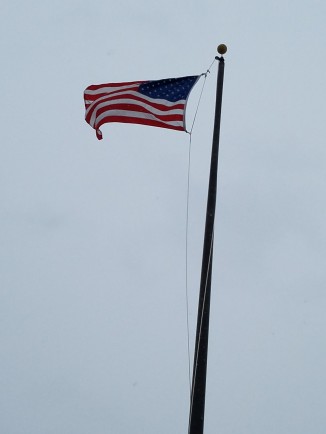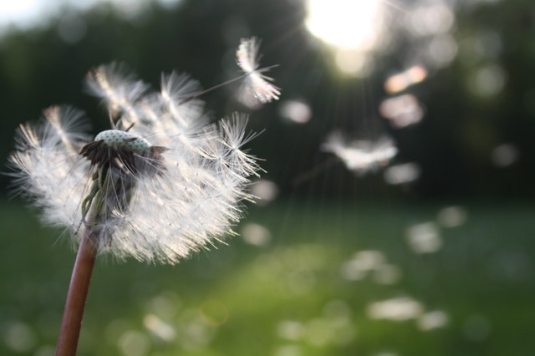
Today was one of those mid-winter days in Southeastern Pennsylvania when it snowed all day, but resulted in only a light coating of snow on the ground. I wanted to do some speed work on the track this morning. The picture above shows what the track looked like. Any reasonable person would have gone inside, changed into shorts and completed the run on a treadmill. Or maybe put on a pair of comfortable pants and fuzzy slippers and grabbed a cup of coffee. Fortunately, I am not reasonable. I ran on the track.
It was not too bad, but I did have to adjust my time expectations. The footing was slippery, and there was one low point on the track that I learned to avoid after the second lap, when I put my foot into some icy water. The most challenging part was running into the wind four times each mile. Here is what the wind looked like:

The wind was howling out of the West. Annie Dillard, in her book Pilgrim at Tinker Creek, draws an analogy between time moving in only one direction and a creek falling over rocks in its stream bed, always moving downstream. She says that if you look upstream, you can see the present coming towards you. Today, I felt the present in the West wind. It was barreling towards me at what felt like gale force.

The present is impossible to catch. As soon as you seek it, it’s gone. Last week I was running on a nearby rail trail. My mind was quiet, and I felt great. When I say I felt great, I mean that I was not aware of any discomfort while running. I was not aware of my hip aching, the weakness that has taken over my left leg, the unusual way I throw my left foot out on every stride. I was totally in the moment, totally present without the deafening rush of thoughts that typically course through my mind. As soon as I internally verbalized that, “Hey! I feel good!”, the moment was gone, and I was aware of my aches and my stride. The door to the present slammed shut. When I became self-aware, I lost the present.

You don’t have to meditate to be “in the moment”. When you are totally absorbed in the present with any activity, you are practicing mindfulness. Mindfulness is a concept typically associated with the Eastern religions of Hinduism and Buddhism. Vedic meditation and yoga were two paths to mindfulness discussed in the Bhagavad Gita, the Hindu scripture. In Buddhism mindfulness (Sati) is thought to be the first step toward enlightenment. Mindfulness, however, is also important in Christianity.

Meister Eckhart, the medieval mystic and Dominican friar, taught detachment from ego. This is very beneficial in concept, but very difficult to do in reality. How can you rid your self of your “self”? In this case, the self refers to all of the negative human traits that begin with “self” such as self-important, self-serving, self-interest, and, of course, selfish. We tend to justify our own selfishness and condemn it in others. Eckhart advocated emptying oneself. This is the basis of Christian contemplative prayer and good advice for achieving peace through mindfulness.
In Philippians Paul writes that Jesus “emptied himself ”. By this, he meant that Jesus’ compassion does not come from a mind that is constantly analyzing, calculating, and measuring. Rather, it comes from a mind that is emptied of self-awareness and self-reference. Through this emptiness, we allow God’s love to shine outward. Our compassion, then, is built upon the ability to empty our minds. Our self-consciousness is not only the thing that separates us from God, it is also what separates us from other human beings.

As a runner, it is tempting to try to catch the wind, to hold on to the present. The wind blows us down the road, and we get slower, achier and less resilient. Maybe we even start to feel sorry for ourselves. We allow our ego to control our outlook. That is why it is important to stand facing the wind, so an ever new, ever fresh present is forever rushing at you. To put your back to the wind is to dwell on a past that is already gone, blown away. Allowing the wind to shape our hearts with tolerance, warmth and love is the best orientation. Rejoice in the headwind!
[…] with others, most of my runs are solo. Running by myself can be a blessing or a chore. If I can be in the moment, lost in my thoughts and having no injury issues, I can solve my problems, work out solutions to […]
LikeLike
[…] is a picture that I took last weekend during a trail run that I did with friends. The day was blustery and cold, typical of early February in Southeastern […]
LikeLike
[…] is much more beneficial to tell myself the story of what is better in my life now. I am more patient, more relaxed, more generous. I notice and appreciate details. I have time to do […]
LikeLike
[…] and do some long runs to train for the race. When we woke up this morning, it was pouring and the wind was whipping the branches around outside our bedroom window. The temperature was in the […]
LikeLike
Rejoicing in the headwind…
To put your back to the wind is to dwell on a past that is already gone, blown away
Thought for the day.
LikeLiked by 1 person
[…] to cheat at running when you are out in the countryside where it’s thirty degrees and the wind is blowing at thirty miles per hour. And the wind always seems to be in your face, no matter which […]
LikeLike
[…] that I love. Last week, however, I decided to do one of my training runs in town, because the wind was whipping, and I thought I would be more protected if I ran between the […]
LikeLike